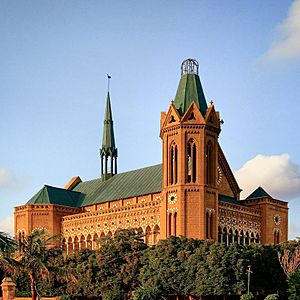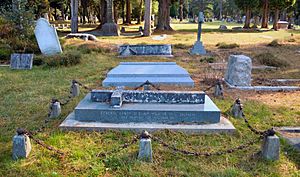Henry St Clair Wilkins facts for kids
Henry St Clair Wilkins (born December 3, 1828 – died December 15, 1896) was a British army officer. He worked for the East India Company in places like India and Aden. He also served in Abyssinia (which is now Ethiopia). Besides being a soldier, he was a famous architect who designed many important buildings.
Contents
Life and Military Career
Henry St Clair Wilkins was born on December 3, 1828. His father was George Wilkins, a church leader in Nottingham. Henry went to a military college run by the East India Company in a place called Addiscombe.
After his training, he became a lieutenant in the Bombay Engineers on June 11, 1847. He rose through the ranks quickly. He became a captain in 1858, then a lieutenant-colonel in 1867. By 1882, he was a full general when he retired from the army.
Serving in Different Lands
In 1858, Wilkins served with the army in Aden (a country in the Middle East). They were fighting against local Arab groups. Later, in 1868, he led the Royal Engineers during the British campaign in Abyssinia.
His commander, Lord Napier of Magdala, praised him for his "invaluable and important services." This means his work was very helpful and important during the expedition. He was even chosen to be an aide-de-camp (a special assistant) to Queen Victoria. He also received a medal for his service.
Amazing Architectural Designs
Henry Wilkins was not just a soldier; he was also a very talented artist and draughtsman. This means he was skilled at drawing plans and designs. He worked in the public works department in British India. His building designs were known for being both useful and beautiful.
Here are some of the famous buildings and projects he designed or helped with:
- In Aden: He helped restore the ancient water tanks in the Tawella Valley. These tanks were built around 600 A.D.
- In Bombay (now Mumbai): He designed the Government and Public Works Secretariats. These were important government offices. He also won first prize for his design of the European General Hospital.
- In Poona (now Pune): He designed several key buildings. These include the Sassoon Hospital, the Deccan College, and the Ohel David Synagogue. He also designed the tomb for David Sassoon and his family members.
- In Bhuj: He designed the palace (Prag Mahal) for the ruler of the Kach region.
- In Bhejapur (Orissa): He helped restore and update old buildings to create a new army station.
Books Written by Wilkins
Wilkins also wrote several books during his lifetime. These books shared his knowledge and experiences:
- Reconnoitring in Abyssinia, published in 1868.
- The Indian Civil Engineering College: Remarks, published in 1871.
- Report on the state and requirements of the Kurrachee harbour works, published in 1878.
- A Treatise on Mountain Roads, Live Loads, and Bridges, published in 1879.
Later Life and Death
Henry St Clair Wilkins passed away suddenly on December 15, 1896. He was at his home in Queen's Gate, South Kensington. In 1856, he had married Violet, who was the daughter of Colonel Colin Campbell McIntyre. Henry and Violet are buried together in Brookwood Cemetery in Surrey, England.
Gallery
Architecture by Wilkins:








